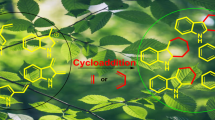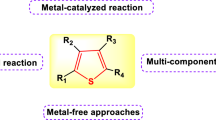Abstract
17-Thienyl-and 17-benzo[b]thienyl-3-hydroxyestra-1,3,5(10),16-tetraenes were synthesized by either sequential or one-pot Suzuki cross-coupling and Wittig olefination reactions. At 160 °C, heteroaryl substituted steroids were observed to undergo thermal intramolecular cyclization to produce E-ring heteroareno-annelated estranes.
Similar content being viewed by others
References
J.A. Kalaitzis, P. de Almeida Leone, L. Harris, M.S. Butler, A. Ngo, J.A.N. Hooper and R.J. Quinn: “Adociasulfates 1, 7 and 8: New Bioactive Hexaprenoid Hydroquinones from the Marine Sponge Adocia sp.”, J. Org. Chem., Vol. 64, (1999), p. 5571.
C.L. Blackburn, C. Hopmann, R. Sakowicz, M.S. Berdelis, L.S.B. Goldstein and D.J. Faulkner: “Adociasulfates 1–6, Inhibitors of Kinesin Motor Proteins from the Sponge Haliclona (aka Adocia) sp.”, J. Org. Chem., Vol. 64, (1999), p. 5565.
C.L. Blackburn and D.J. Faulkner: “Adociasulfate 10. A New Merohexaprenoid Sulfate from the Haliclona (aka Adocia) sp.”, Tetrahedron, Vol. 56, (2000), p. 8429.
P. Crews and B. Harrison: “Triterpene-Ketides (Merotriterpenes), Haliclotriol A and B, from an Indo-Pacific Haliclona Sponge”, Tetrahedron, Vol. 56, (2000), p. 9039.
G. Cimino, P. de Luca, S. de Stefano and L. Minale: “Disidein, a Pentacyclic Sesterterpene Condensed with a Hydroxyhydroquinone Moiety, from the Sponge Disidea Pallescens”, Tetrahedron, Vol. 31, (1975), p. 271.
M. Bogenstaetter, A. Limberg, L.C. Overman and A.L. Tomasi: “Enantioselective Total Synthesis of the Kinesin Motor Protein Inhibitor Adociasulfate 1”, J. Am. Chem. Soc., Vol. 121, (1999), p. 12206.
T. Matsumoto, M. Watanabe, S. Mataka and T. Thiemann: “Estrano[17,16-e]pyrimidine-peptide Conjugates”, Steroids, Vol. 68, (2003), p. 751.
F. Di Riccardis, D. Meo, I. Izzo, M. Di Filippo and A. Casapullo: “Design and Synthesis of Estrarubicin. A Novel Class of Estrogen-anthracenedione Hybrids”, Eur. J. Org. Chem., 1998, p. 1965.
T. Thiemann, M. Watanabe and S. Mataka: “Areno-annelated estra-1,3,5(10),6,8,11,14,16-octaenes”, New J. Chem., Vol. 25, (2001), p. 1104.
M. Watanabe, S. Mataka and T. Thiemann: “Benzothieno and Benzofurano Annelated Estranes”, Steroids, Vol. 70, (2005), p. 856.
J.M. Allison, D. Burn, F.K. Butcher, M.T. Davies and U. Petrow: “Modified Steroid Hormones — XLVII: Some Further Pentacyclic Types”, Tetrahedron, Vol. 23, (1967), p. 1515
M. Watanabe, T. Matsumoto, S. Mataka and T. Thiemann: “3-Methoxy-19-norpentara-1,3,5(10),17(20)-tetraen-21-one”, Acta Cryst. Sect. E, Vol. E61, p. 0169.
P.K. Patra, J.R. Suresh, H. Ila and H. Junjappa: “An Expedient New Synthesis of Substituted Carbazoles via α-Oxoketene Acetals through Heteroaromatic Annelation Methodology”, Tetrahedron Lett., Vol. 38, (1997), p. 3119
K. Gupta, K.M. Yadav, B. Patro, H. Ila and H. Junjappa: “Synthesis of D-ring Functionalized and D-Benzo/hetero-annulated Estrone Derivatives via α-Oxoketene Dithioacetal”, Synthesis, 1995, p. 841.
G. Desimoni, G. Tacconi, A. Barco and G.P. Pollini: Natural Products Synthesis through Pericyclic Reactions, ACS Monograph 180. American Chemical Society, Washington DC, 1983.
T. Thiemann, M. Watanabe, Y. Tanaka and S. Mataka: “One Pot Suzuki Coupling — Wittig Olefination Reactions”, J. Chem. Res., (2004), p. 723.
M. Watanabe, S. Mataka and T. Thiemann: “Facile Access to Condensed Arenothiophenes — Preparation of Dihydrophenanthrothiophenes and Dihydrophenanthrobenzo[b]thiophenes”, J. Chem. Res., 2005, p. 564.
Z. Arnold and A. Holy: “Synthetic Reactions of Dimethylformamide. XIV. Some New Findings on Adducts of the Vilsmeier-Haack Type”, Collect. Czech Chem. Commun., Vol. 27, (1962), p. 2886
T. Thiemann, B. Gehrcke and A. de Meijere: “Dimerisation of an Allylidenecyclopropane at a Surprisingly Low Temperature”, Synlett, 1993, p. 483
for a review, see: C.M. Marson: “Reactions of Carbonyl Compounds with (Monohalo) Methyleniminium Salts (Vilsmeier Reagents)”, Tetrahedron, Vol. 48, (1992), p. 3659.
R.A.W. Johnstone and M.E. Rose: “A Rapid, Simple and Mild Procedure for Alkylation of Phenols, Alcohols, Amides and Acids”, Tetrahedron, Vol. 35, (1979), p. 2169.
J. Hart, W.P. Hong and L.Y. Hsu: “Total Synthesis of Lythrancepine II and Lythrancepine III”, J. Org. Chem., Vol. 52, (1987), p. 4665.
T. Thiemann, C. Thiemann, S. Sasaki, V. Vill, S. Mataka and M. Tashiro: “Synthesis and Photochemistry Behaviour of 3-(Estran-16-yl)acrylates and 2-(Estran-16-yl)vinyl ketones”, J. Chem. Res., (1997), p. 1728.
For the use of (Ph3P)2PdCl2 in Suzuki cross-coupling reactions in the synthesis of biaryls and bishetaryls, see: (a) A. Suzuki: “Cross-Coupling of Organoboron Compounds with Organic Halides”, In: Metal Catalysed Cross-Coupling Reactions, F. Diederich, P.J. Stang (Eds.), VCH-Wiley, pp. 49
M. Melucci, G. Barbarella and G. Sotgiu: “Solvent-free, Microwave-assisted Synthesis of Thiophene Oligomers via Suzuki-coupling”, J. Org. Chem., Vol. 67, (2002), p. 8877.
M. Watanabe, G.R. Morais, S. Mataka, K. Ideta and T. Thiemann: “Two Variations of Solvent-Reduced Wittig Olefination Reactions — Comparison of Solventless Wittig Reactions to Wittig Reactions under Ultrasonication with Minimal Work-up”, Z. f. Naturforschg., Vol. 60B, (2005), p. 909.
T. Thiemann, M. Watanabe, Y. Tanaka and S. Mataka: “Solvent-free Wittig Olefination with Stabilized Phosphoranes — Scope and Limitations”, New J. Chem., Vol. 28, (2004), p. 578.
G. Desimoni, G. Faita, S. Guidetti and P.P. Righetti: “Solvent Effect in Pericyclic Reactions. XI. The Electrocyclic Reaction”, Eur. J. Org. Chem., (1999), p. 1921 and ref. cited.
K. Voigt, P. von Zezschwitz, K. Rosauer, A. Lansky and A. de Meijere: “The Twofold Heck Reaction on 1,2-dihalocycloalkenes and Subsequent 6 pi-Electrocyclization of the Resulting (E,Z,E)-1,3,5-Hexatrienes: A New Formal {2+2+2}-assembly of Six-membered Rings”, Eur. J. Org. Chem., (1998), p. 1521.
P. von Zezschwitz, F. Petry and A. de Meijere: “A One-pot Sequence of Stille and Heck Couplings: Synthesis of Various 1,3,5-Hexatrienes and Their Subsequent 6 pi-Electrocyclization”, Chem. Eur. J., Vol. 7, (2001), p. 4035.
T.L. Gilchrist and R.J. Summersell: “Synthesis of Chrysenes and Other A-fused Phenanthrenes by a Palladium(0) Coupling Electrocyclic Ring-closure Reaction”, J. Chem. Soc., Perkin Trans. 1, (1988), p. 2595.
O. Isler, H. Gutmann, M. Montavon, R. Ruegg, G. Ryser and P. Zeller: “Anwendung der Wittig Reaktion zur Synthese von Estern des Bixins und Croatins”, Helv. Chim. Acta, Vol. 40, (1957), p. 1242.
F. Ramirez and S. Dershowitz: “Phosphinemethylenes. II. Triphenylacylmethylenes”, J. Org. Chem., Vol. 22, (1957), p. 41.
A. Altomare, M.C. Burla, M. Camalli, G. Cascarano, C. Giacovazzo, A. Guagliardi, A.G.G. Moliterni, G. Polidori and R. Spagna: “SIR 97: A New Tool for Crystal Structure Determination and Refinement”, J. Appl. Cryst., Vol. 32, (1999), p. 115.
D.J. Watkin, C.K. Prout, C.K. Carruthers and P.W. Betteridge: CRYSTALS, Version 10, (1996), Chemical Crystallography Laboratory, Oxford, UK, as used in Rigaku: “CrystalClear”, Version 1.3.5, (1999), Rigaku Corporation, 3-9-12 Akishima, Tokyo, Japan.
Rigaku/MSC, CrystalStructure, Version 3.6.0 (2004); Rigaku-MSC, 9009 New Trails Drive, The Woodlands, TX 77381-5209, USA.
D. Cremer and J.A. Pople: “General Definition of Ring Puckering Coordinates”, J. Am. Chem. Soc., Vol. 97, (1975), p. 1354.
J.C.A. Boeyens: “Conformation of 6-Membered Rings”, J. Cryst. Mol. Struct., Vol. 8, (1978), p. 317.
S.T. Rao, E. Westhoff and M. Sundaralingam: “Exact Method for the Calculation of Pseudorotation Parameters P, τm and Their Errors. A Comparison of the Altona-Sundaralingam and Cremer-Pople Treatment of Puckering of Five-membered Rings”, Acta Cryst., Sect. A, Vol. A37, (1981), p. 421.
for distances that define CH-pi interactions, see: (a) M. Nishio and M. Hirota: “CH/π Interaction: Implications in Organic Chemistry”, Tetrahedron, Vol. 45, (1989), p. 7201
M. Nishio, M>Hirota and Y. Umezawa: The C-H···π Interaction — Evidence, Nature and Consequences, Wiley — VCH, New York, 1998.
Author information
Authors and Affiliations
About this article
Cite this article
Watanabe, M., Matsumoto, T., Mataka, S. et al. Heteroareno-annelated estranes by triene cyclization. cent.eur.j.chem. 4, 375–402 (2006). https://doi.org/10.2478/s11532-006-0016-2
Received:
Accepted:
Issue Date:
DOI: https://doi.org/10.2478/s11532-006-0016-2




